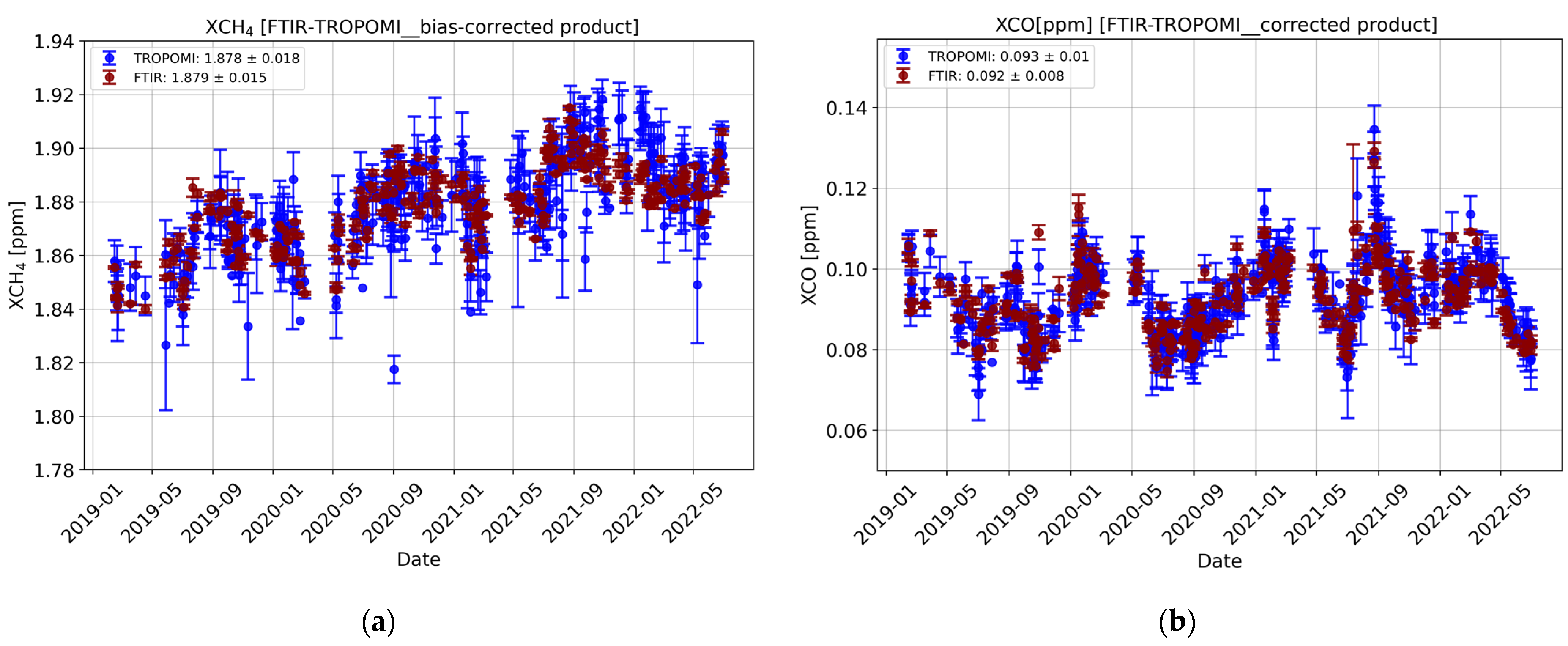Sentinel-5P/TROPOspheric Monitoring Instrument CH4 and CO Total Column Validation over the Thessaloniki Collaborative Carbon Column Observing Network Site, Greece †
Abstract
:1. Introduction
2. Methodology
3. Results
4. Conclusions
Author Contributions
Funding
Informed Consent Statement
Data Availability Statement
Acknowledgments
Conflicts of Interest
References
- Mermigkas, M.; Topaloglou, C.; Balis, D.; Koukouli, M.E.; Hase, F.; Dubravica, D.; Borsdorff, T.; Lorente, A. FTIR Measurements of Greenhouse Gases over Thessaloniki, Greece in the Framework of COCCON and Comparison with S5P/TROPOMI Observations. Remote Sens. 2021, 13, 3395. [Google Scholar] [CrossRef]
- IPCC. Climate Change 2014: Mitigation of Climate Change. Contribution of Working Group III to the Fifth Assessment Report of the Intergovernmental Panel on Climate Change; Edenhofer, O., Pichs-Madruga, R., Sokona, Y., Farahani, E., Kadner, S., Seyboth, K., Adler, A., Baum, I., Brunner, S., Eickemeier, P., et al., Eds.; Cambridge University Press: Cambridge, UK; New York, NY, USA, 2014. [Google Scholar]
- Dlugokencky, E.J.; Nisbet, E.G.; Fisher, R.; Lowry, D. Global atmospheric methane: Budget, changes and dangers. Philos. Trans. A Math. Phys. Eng. Sci. 2011, 369, 2058–2072. [Google Scholar] [CrossRef] [PubMed]
- Hase, F.; Frey, M.; Blumenstock, T.; Gros, J.M.; Kiel, M.; Kohlhepp, R.; Tsidu, G.M.; Schafer, K.V.R.; Sha, M.K.; Orphal, J. Application of portable FTIR spectrometers for detecting greenhouse gas emissions of the major city Berlin. Atmos. Meas. Tech. 2015, 8, 3059–3068. [Google Scholar] [CrossRef]
- Wunch, D.; Toon, G.C.; Blavier, J.-F.L.; Washenfelder, R.A.; Notholt, J.; Connor, B.J.; Griffith, D.W.T.; Sherlock, V.; Wennberg, P.O. The total carbon column observing network. Philos. Trans. R. Soc. A Math. Phys. Eng. Sci. 2011, 369, 2087–2112. [Google Scholar] [CrossRef] [PubMed]
- Lambert, J.-C.; Compernolle, S.; Eichmann, K.-U.; de Graaf, M.; Hubert, D.; Keppens, A.; Kleipool, Q.; Langerock, B.; Sha, M.K.; Verhoelst, T.; et al. (Eds.) Quarterly Validation Report of the Copernicus Sentinel-5 Precursor Operational Data Products #06: April 2018–February 2020. In ESA MPC S5P MPC. Routine Operations Consolidated Validation Report; S5P MPC Routine Operations Consolidated Validation Report Series; Issue #06, Version 06.0.1; Tropomi: Utrecht, The Netherlands, 2020; p. 154. [Google Scholar]
- Lorente, A.; Borsdorff, T.; Butz, A.; Hasekamp, O.; De Brugh, J.A.; Schneider, A.; Wu, L.; Hase, F.; Kivi, R.; Wunch, D.; et al. Methane retrieved from TROPOMI: Improvement of the data product and validation of the first 2 years of measurements. Atmos. Meas. Tech. 2021, 14, 665–684. [Google Scholar] [CrossRef]
- Knapp, M.; Kleinschek, R.; Hase, F.; Agustí-Panareda, A.; Inness, A.; Barré, J.; Landgraf, J.; Borsdorff, T.; Kinne, S.; Butz, A. Shipborne measurements of XCO2, XCH4, and XCO above the Pacific Ocean and comparison to CAMS atmospheric analyses and S5P/TROPOMI. Earth Syst. Sci. Data 2021, 13, 199–211. [Google Scholar] [CrossRef]
- Borsdorff, T.; De Brugh, J.A.; Pandey, S.; Hasekamp, O.; Aben, I.; Houweling, S.; Landgraf, J. Carbon monoxide air pollution on sub-city scales and along arterial roads detected by the Tropospheric Monitoring Instrument. Atmos. Chem. Phys. 2019, 19, 3579–3588. [Google Scholar] [CrossRef]
- Sha, M.K.; Langerock, B.; Blavier, J.-F.L.; Blumenstock, T.; Borsdorff, T.; Buschmann, M.; Dehn, A.; De Mazière, M.; Deutscher, N.M.; Feist, D.G.; et al. Validation of methane and carbon monoxide from sentinel-5 precursor using TCCON and NDACC-IRWG stations. Atmos. Meas. Tech. 2021, 14, 6249–6304. [Google Scholar] [CrossRef]



| X-Gas | Relative Mean Bias (%) | S-5P Mean (ppm) |
|---|---|---|
| XCH4 | −0.01 ± 0.6 | 1.87 ± 0.01 |
| XCO | +0.62 ± 4.2 | 0.09 ± 0.01 |
Disclaimer/Publisher’s Note: The statements, opinions and data contained in all publications are solely those of the individual author(s) and contributor(s) and not of MDPI and/or the editor(s). MDPI and/or the editor(s) disclaim responsibility for any injury to people or property resulting from any ideas, methods, instructions or products referred to in the content. |
© 2023 by the authors. Licensee MDPI, Basel, Switzerland. This article is an open access article distributed under the terms and conditions of the Creative Commons Attribution (CC BY) license (https://creativecommons.org/licenses/by/4.0/).
Share and Cite
Mermigkas, M.; Topaloglou, C.; Koukouli, M.-E.; Balis, D.; Hase, F.; Dubravica, D.; Borsdorff, T.; Lorente, A. Sentinel-5P/TROPOspheric Monitoring Instrument CH4 and CO Total Column Validation over the Thessaloniki Collaborative Carbon Column Observing Network Site, Greece. Environ. Sci. Proc. 2023, 26, 188. https://doi.org/10.3390/environsciproc2023026188
Mermigkas M, Topaloglou C, Koukouli M-E, Balis D, Hase F, Dubravica D, Borsdorff T, Lorente A. Sentinel-5P/TROPOspheric Monitoring Instrument CH4 and CO Total Column Validation over the Thessaloniki Collaborative Carbon Column Observing Network Site, Greece. Environmental Sciences Proceedings. 2023; 26(1):188. https://doi.org/10.3390/environsciproc2023026188
Chicago/Turabian StyleMermigkas, Marios, Chrysanthi Topaloglou, Maria-Elissavet Koukouli, Dimitrios Balis, Frank Hase, Darko Dubravica, Tobias Borsdorff, and Alba Lorente. 2023. "Sentinel-5P/TROPOspheric Monitoring Instrument CH4 and CO Total Column Validation over the Thessaloniki Collaborative Carbon Column Observing Network Site, Greece" Environmental Sciences Proceedings 26, no. 1: 188. https://doi.org/10.3390/environsciproc2023026188
APA StyleMermigkas, M., Topaloglou, C., Koukouli, M.-E., Balis, D., Hase, F., Dubravica, D., Borsdorff, T., & Lorente, A. (2023). Sentinel-5P/TROPOspheric Monitoring Instrument CH4 and CO Total Column Validation over the Thessaloniki Collaborative Carbon Column Observing Network Site, Greece. Environmental Sciences Proceedings, 26(1), 188. https://doi.org/10.3390/environsciproc2023026188







